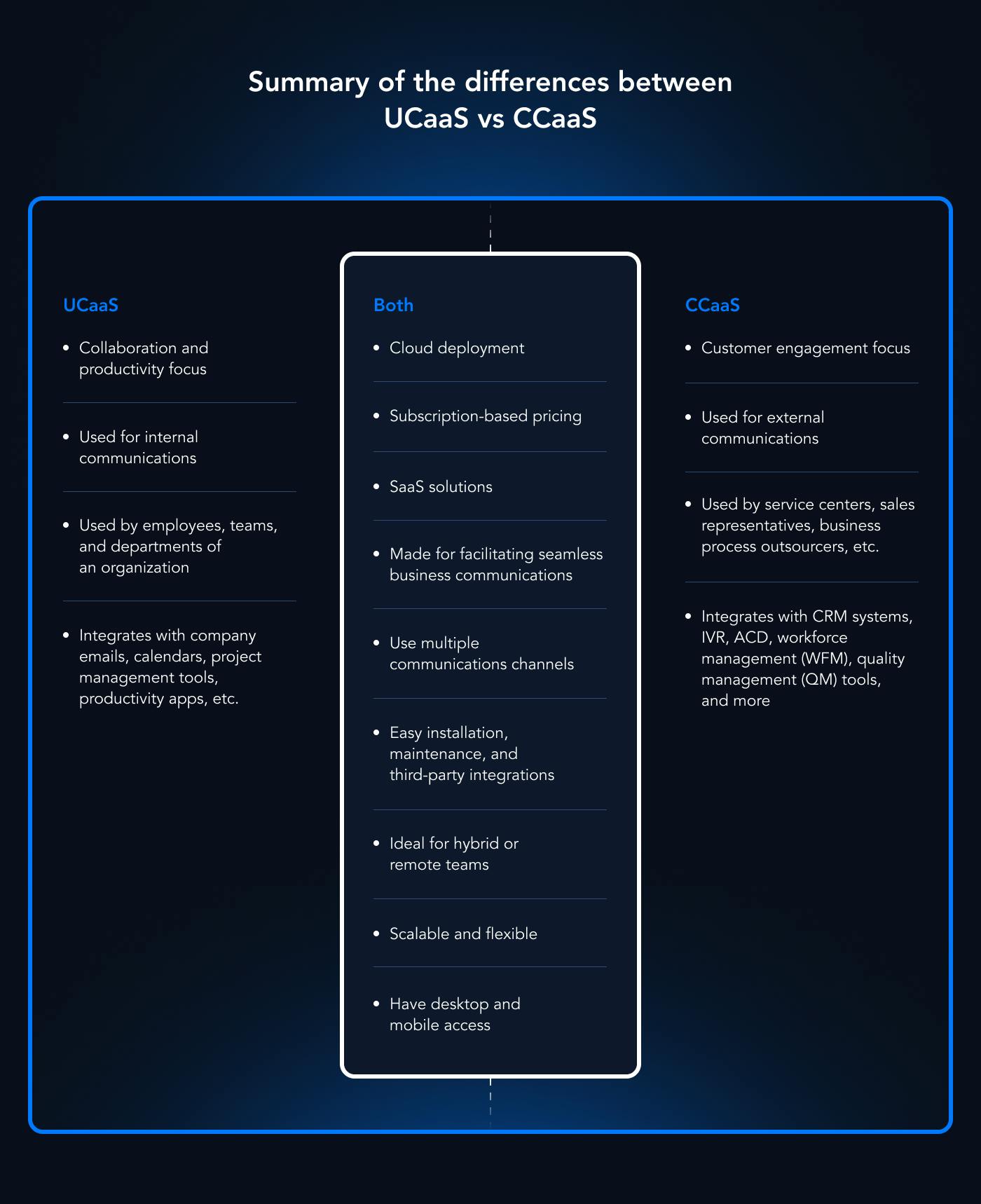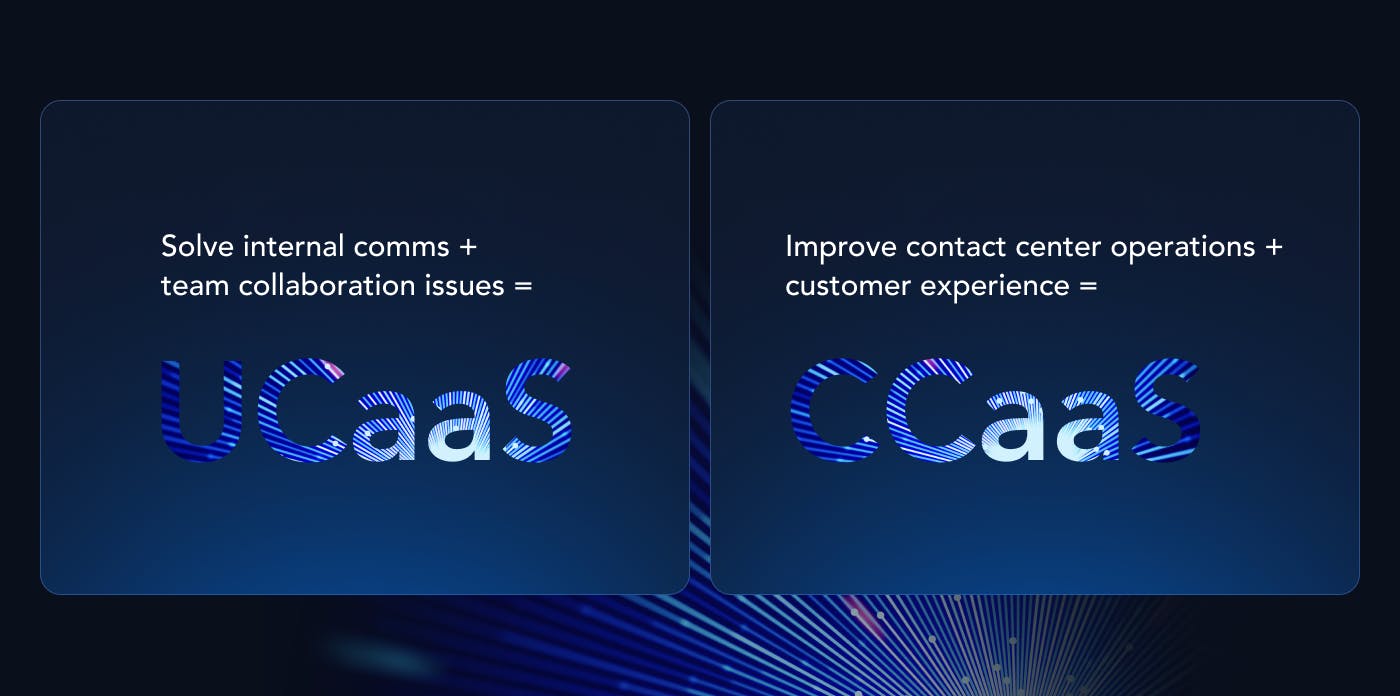UCaaS vs CCaaS: Which is Right for Your Business?


UCaaS vs CCaaS
Unified Communications as a Service (UCaaS) and Contact Center as a Service (CCaaS) are often used side by side in articles listing business communications solutions as they operate on similar technologies. Both are cloud-based SaaS (software-as-a-service) solutions that facilitate seamless communications, yet their functions and customer base differ significantly.
The biggest distinction is that while UCaaS was designed for internal business communication, CCaaS was made for external business communication, that is customer-facing interactions. Yet, since both solutions involve communication, they have overlapping capabilities. That’s why the market started to move toward integrating these two platforms, creating UCaaS and CCaaS convergence to simplify operations and communications.
In this guide, we’ll further define the difference between CCaaS vs UCaaS , how they work, highlight their main advantages, discuss UCaaS and CCaaS integration possibilities , and help you find the right solution for your business.
What Is UCaaS?
Unified Communications as a Service streamlines communications by bringing voice, messages, video conferencing, and other communication and collaboration tools into a single platform.
Originally intended to enable remote work and enhance employee productivity across company locations, UCaaS is mainly used to improve communication, collaboration, and productivity among employees and across departments of an organization. It’s great for enabling hybrid or remote teams to work together seamlessly.
In short, UCaaS is best used for intra-organizational communications.
What Is CCaaS?
On the other hand, Contact Center as a Service is primarily a customer experience (CX) platform that allows organizations to consistently and efficiently manage all their contact center interactions from a single solution.
Using CCaaS, businesses can manage all sorts of communications channels, including voice calls, emails, text messages, chats, and social media messages from one place, while also keeping operational costs low.
CCaaS solutions are mostly used by customer and employee support service centers, telemarketing centers, business process outsourcers, and other similar communications operations. CCaaS platforms provide companies with cost-effective, multi-channel contact center capabilities that answer their changing needs and requirements.
With a next-generation CCaaS solution, a contact center can significantly improve CX and customer satisfaction.
In short, CCaaS is best used for customer-facing communications.
You can learn more about what CCaaS is, its evolution, capabilities, benefits, and more in our CCaaS-focused article here
Similarities Between UCaaS vs. CCaaS
As stated above, Unified Communications and Contact Center as a Service solutions have overlapping features.
Both UCaaS and CCaaS platforms run on the same technology: they are cloud-based SaaS solutions. Deployed in the cloud and sold as a subscription service, they don’t require large upfront investments—and the ongoing operational costs are also lower than for their on-premises counterparts.
Instead, vendors charge for the actual use of the software, which can be scaled up or down as needed.
Because providing seamless business communications is the most crucial goal of both solutions, their capabilities revolve around making sure communications channels are not siloed and fragmented. Both CCaaS and UCaaS seek to engage customers and employees in a seamless, omnichannel way.
Differences Between UCaaS vs. CCaaS
At first sight, CCaaS and UCaaS may look very similar, especially looking at their abbreviated forms. However, their full names already reveal the main functionality and customer base differences between them.
Purpose
| As its name implies, Unified Communications deals predominantly with unifying communications within an organization. It streamlines business interactions between employees, teams, and departments by connecting communication and productivity tools into an easy-to-use interface. | As opposed to that, the primary aim of Contact Center as a Service is to enable contact center agents to effectively engage with their customers. Knowing how demanding today’s consumers are, providing seamless customer communications is key to business success. |
Audience
Because CCaaS and UCaaS serve different audiences, it’s not surprising that the channels they use are slightly distinct.
While employees using UCaaS platforms mainly rely on emails, video or voice calls, chat, and file sharing on collaboration software such as Microsoft Teams, Slack, Zoom, etc., customers turning to support agents mostly favor digital channels , such as in-app chat, and Facebook, Instagram, or other social media messages.
Although the range of communications channels differs from company to company, it’s not very common for colleagues to use, let’s say, LinkedIn chat for corporate communications. A contact center agent, however, may spend most of their day with customer interactions on various social media channels.

Capabilities
Besides the communications channels they use, the capabilities of CCaaS and UCaaS also differ. Although both technologies offer call routing, CCaaS platforms have additional features that help improve customer satisfaction, such as:
- Automatic call distribution (ACD)
- Interactive voice response (IVR)
- Call queuing
- Contact center analytics
- Customer authentication
The latest, next-generation CCaaS platforms also use AI-powered bots, virtual assistants, and AI-led analytics to continuously increase CX automation in the contact center while reducing operating costs.
If you’re interested in how an open CCaaS strategy can save your organization money, read this article

Now that we’ve uncovered the most important similarities and differences between these platforms, let’s take a look at the main advantages of CCaaS vs. UCaaS.
The Advantages of UCaaS vs. CCaaS
The best way to compare CCaaS vs UCaaS is to explore their advantages one by one. As these technologies are predominantly used by different audiences, their main benefits also differ, but there are some overlaps.
Advantages of UCaaS
By connecting business communication and productivity tools into a single interface, UCaaS can realize various benefits for all kinds of organizations, including:
- Improved internal communication
- Streamlined collaboration
- Scalability and flexibility
Let’s see what each of these advantages means in detail:
Made for enabling remote and hybrid work, UCaaS platforms can highly enhance employee productivity across multiple locations.
No matter if a team sits side by side in an office, is scattered across the globe, or works from the comfort of their homes, UCaaS can bring them together for effective collaboration.
It can eliminate the hassle of having to use different intra-organizational communication tools at once and consequently enhance employee experience and team productivity for any team.
Today’s teams work across the globe using multiple video, voice, messaging, file sharing, etc., tools simultaneously. Without UCaaS bringing all these into one platform, employees would have to keep switching back and forth between countless tools.
It would not only be time consuming and lead to higher risk of error but also raise various security and privacy concerns – think of file sharing or handling sensitive customer information.
Companies implementing a UCaaS platform can enable their teams to work together effectively. It can significantly decrease the level and frequency of miscommunication, while increasing turnaround times.
UCaaS can also help a company’s workforce optimization (WFO) efforts. Some UCaaS platforms also include task management features, allowing employees to easily understand their workflows and timelines, keep track of their tasks and deadlines, and assign tasks to their teams and colleagues
Handling internal communications across teams doesn’t require as extensive capabilities as customer communication. Hence, UCaaS platforms usually only offer inbound and outbound voice and video calling, as well as some call routing capabilities. This leads to lower prices than its CCaaS counterparts that have more features.
Thanks to the subscription model, it’s more cost-effective to purchase a UCaaS platform than individual packages for each and every communication and productivity tool your company might need. The cloud deployment also reduces costs, as there’s no need for physical hardware while allowing companies to scale up or down with organizational changes. Additional functionalities and integrations can further enhance a company’s efforts for seamless operations.
Advantages of CCaaS
Using CCaaS platforms, especially next-generation open CCaaS platforms , brings about plenty of business benefits that increase customer satisfaction and CX automation, including:
- Flexibility
- Continuous improvements
- Easy integrations
- Cost-efficiency
- Improved customer experience.
Now let’s take a look at the advantages of CCaaS one by one:
CCaaS solutions are agile and scalable, offering contact centers the flexibility to efficiently react to changing customer and business needs. With next-generation CCaaS , companies can keep existing investments that are still working for them. Then they can evolve step by step toward a best-practice customer engagement operation and grow CX automation along the way.
In customer engagement, the only constant is change.
Whether it’s new channels or new technologies, an organization cannot be anchored down by an obsolete system that’s difficult to phase out. CCaaS platforms can keep up with quickly evolving technologies, helping organizations take advantage of new and innovative capabilities without disruption.
Leading CCaaS vendors offer a broad and integrated suite and easy integrations with existing workflows and don’t require fundamental changes to an organization’s technical ecosystem.
The easy-to-adopt capabilities work with existing cloud-based platforms or on-premises applications, including WFO and workforce management(WFM) tools that improve agent performance and CX. You don’t need to rip and replace everything at once.
Because CCaaS solutions are hosted in the cloud, contact centers can reduce or even remove their on-premises IT expenses, including software, hardware, hosting and maintenance costs. Furthermore, because CCaaS is subscription based, vendors charge for the actual use of the software, which can be scaled up or down as needed.
There’s no need for large upfront investments, and the ongoing operational costs are also lower than what on-premises contact center solutions offer.
Thanks to the omnichannel support and automation next-generation CCaaS solutions provide, the customer demand for smooth interactions and self-service can be easily met. Market-leading CCaaS vendors have a comprehensive approach to integrating generative AI technology that can further improve CX and facilitate AI business outcomes with real-time agent assistance, knowledge management, and more.
With that, and by capturing critical customer data for every agent to use, these solutions can offer highly personalized CX, keeping customers at the center of attention.
You can read more about the differences between first-generation and next-generation CCaaS and the future of contact centers here
UCaaS and CCaaS Convergence
As mentioned earlier, UCaaS and CCaaS solutions have multiple overlapping capabilities, which opened doors to convergence possibilities of these two platforms . Many think that CCaaS and UCaaS convergence would not only allow for enhanced CX for a lower price tag but could better serve the growing customer demand for seamless omnichannel customer experiences.
A truly integrated UCaaS and CCaaS platform could be beneficial for each communications player, namely:
- Customers who demand elevated experiences and flawless interactions with brands.
- Employees who require flexibility, remote work, value-added work, and enhanced agent experience (AX).
- Companies that need to find the right balance between these growing customer and employee needs while keeping operational costs at bay.
Seemingly UCaaS and CCaaS convergence is a win-win for all, but the picture is never as simple as it first appears.
As the transformative trend of combining UCaaS and CCaaS is gaining ground, it’s important to understand the advantages and costs. Let’s take a closer look at them!
Advantages of UCaaS and CCaaS Convergence
By bringing unified communications and contact center capabilities together into a single platform, companies can simplify and standardize their internal and external communications. Doing so can lead to improved efficiency and lower costs, which is ultimately what every company is aiming for.
But how exactly?
Using multiple tools and applications for internal and external communications takes time. Agents have to learn different software, not to mention the time they spend switching back and forth between them daily. If they get to stick to one single platform enabled via standardized processes, that can save significant amounts of time on their training and potential IT support needs.
In addition to agents, supervisors and management can also highly benefit from the simplified administration processes UCaaS and CCaaS convergence can achieve.
Bringing all communication channels together into a single platform from the first customer interaction until the inquiry resolution can generate invaluable insights across the entire customer journey.
Such insights can help further customize and personalize customer interactions, which is what customers expect.
Greater agent efficiency and productivity can, in itself, help result in enhanced customer service and increased, more seamless CX. Support agents that have an easy way of reaching out to in-house experts through integrated UCaaS tools during a customer interaction can not only make their day-to-day job easier but can more easily focus on value-added interactions.
If the platform also puts AI power at the agent’s fingertips to help them solve customer issues quickly, they can help customers realize AI business outcomes, too.
Costs of UCaaS and CCaaS Convergence
As we’ve just seen, a converged UCaaS and CCaaS platform comes with a multitude of benefits, but bringing these two solutions together may come at a cost, including integration and network stability issues, as well as maintenance costs.
Let’s investigate these potential challenges and see how to avoid them:
Depending on the amount and types of your company’s current internal and external communications tools, integrating them into one single platform may not be as quick and easy as it seems.
Unless you’re starting from scratch and ready to invest in a new converged UCaaS-CCaaS solution, or willing to go through a complete rip-and-replace process, you’re likely looking at a pricey and painful integration journey. To avoid that, you should examine UCaaS and CCaaS providers to see what exactly you need.
Speaking of pricey, it’s not only the integration that may cost more than you’d expect, but the maintenance of the combined tools, too. Although one of the main goals of integrating UCaaS and CCaaS platforms is lowering costs, if you decide to keep some of your systems on-premises, you can easily end up with increasing costs and decreased scalability.
Clearly these are not the preferred outcomes of such a convergence. Except for a few specific use cases, the way forward is almost always in the cloud.
Another detail you should not take lightly when considering UCaaS and CCaaS integration is your business’ network capabilities. Before bringing all your communications into a single platform, you must ensure your network is stable enough and can keep up with the increased volumes.
Without that, not only will your internal communications be negatively affected but also your contact center capabilities, and hence, customer experience.
Factors to Consider When Choosing UCaaS vs CCaaS
Now that we’ve gone through the definitions, the main advantages, and the convergence trends of UCaas vs CCaaS, it’s time to find out whether your business could best benefit from having UCaaS, CCaaS, or both.

The short answer would be this:
- If you’re looking to solve your internal communications and team collaboration issues, you can best benefit from UCaaS.
- If you want to improve your contact center operations and customer experience, CCaaS – especially next-generation Open CCaaS solutions – will be your best bet.
- And if improving both your internal and external communications is your goal, go for a converged UCaaS-CCaaS solution.
However, as ideal as the combined solution may sound, we’d advise against making hasty decisions based on such simple statements only. Each organization is different and has its specific needs and goals, so a personalized solution will always work more in your favor than a ready-made one.
You simply can’t skip putting the work into researching UCaaS vs. CCaaS, and their integration possibilities with your specific business goals in mind.
To help you get started, we’ve collected the most important factors to consider before choosing your business communication solution:

Why Choose Verint for CCaaS?
For 25 years, Verint has been providing market leading business applications designed to seamlessly work with whatever current communication platforms are being used and insulating business users from negative impacts of disruption.
Unlike most CCaaS providers, Verint doesn’t require companies to complete long, disruptive, and risky ‘rip and replace’ processes to take advantage of our capabilities. Our open, modular platform allows you to increase CX automation at your own pace and with minimal operational disruption.
You can choose applications or bots that meet your most pressing needs and see ROI immediately, while keeping the existing solutions that work for you.
Today, Verint AI-powered Routing uses contextual data to intelligently distribute customer interactions to the right resource at the right time across digital and voice channels. AI-powered Routing works seamlessly with Verint’s Channel Automation solution which unifies customer interactions across telephony and digital channels in a single agent workspace. This makes it easy to provide consistent customer experiences across channels, leverage automation that makes self-service simple, and deploy staff flexibly—all with fewer resources and less effort.
Verint is uniquely positioned to help brands increase CX automation with our cloud-native Open Platform with behavioral data and Verint Da Vinci™ AI at the core. Our platform offers brands a broad range of best-of-breed capabilities that are specifically designed to deliver tangible ROI.
Verint Open Platform makes it easy to start taking advantage of cloud capabilities while keeping some of your technology, including your telephony, on-premises. You can even start by simply adding AI-powered bots to your existing on-premises deployment to begin seeing the benefits of the cloud and realize AI business outcomes now.
Read more about Verint Open Platform here.
Frequently Asked Questions about UCaaS vs CCaaS
UCaaS stands for Unified Communications as a Service which brings voice, messages, video conferencing, and other means of communications into a single platform. It’s mainly used for enhancing communication and productivity within an organization.
CCaaS stands for Contact Center as a Service; it’s a customer experience platform that allows organizations to manage all their customer-facing communications from a single solution.
Both UCaaS and CCaaS are business communications platforms, but each is designed for specific business needs and requirements. To be able to make an informed decision on which solution would be best for your business, consider these factors:
- Business needs and communications requirements
- Pain points
- Pricing
- Integration options
- Growth prospects and future needs
Originally designed to enable remote work and enhance employee productivity across locations, UCaaS is more suitable for improving internal communication and collaboration between employees and across departments of an organization.
At the same time, CCaaS is more suitable for improving customer communications and comes with a wider set of capabilities.